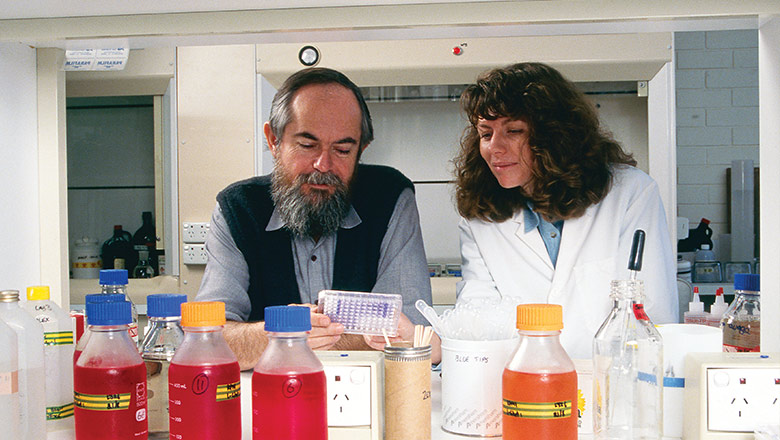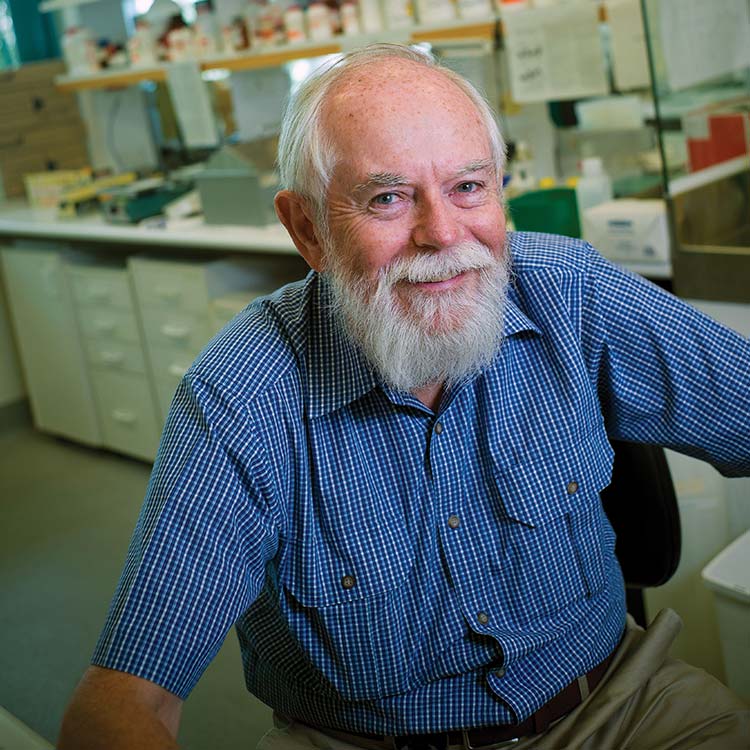How Professor Pat Holt changed what we thought we knew about asthma
Findings by Professor Pat Holt revealed researchers worldwide had been heading down the wrong path and needed a complete turnaround in their battle strategy against respiratory allergy and asthma.
His work at The Kids Research Institute Australia was crucial to the realisation that the key to guarding against such disease lay in aiding the maturing immune system of the infant to “switch on” a protective mechanism which actively suppressed the development of allergic sensitisation.
This normally occurred through early exposure to potential allergy-causing inhaled particles, during the first few years of life.
Up to this point, the advice had been to reduce the child’s exposure to environmental airborne particles, such as dust mites and pollen, as much as possible, particularly in the home.
Through Professor Holt’s work, it was also understood that the complete or partial failure to “switch on” this protective tolerance mechanism in early childhood could lead to the progressive build-up of a harmful immune response that persisted into adulthood and could cause asthma and chronic hay fever.
It also helped reveal that children in families prone to allergic asthma have a tendency for slow maturation of immune function during infancy, resulting in a reduced capacity to develop this protective tolerance.
The key discovery was when Professor Holt proved that the main cause of respiratory allergy was not due to the “leakiness” of protective barrier membranes lining the airway surfaces in the lung, as had been widely thought. Up to then, it had been believed that this “leakiness” enabled proteins leached from inhaled particles to penetrate into the body, wrongly coming in contact with the immune system and triggering an inflammatory response in susceptible individuals.
He showed that the normal response of the body to inhalation of airborne particles that can trigger respiratory allergy and asthma is the development of highly specific anti-inflammatory immune responses known as “immunological tolerance”. These suppress the production of the airborne-particle-specific IgE antibodies that are responsible for allergic symptoms.
“So we realised instead of passive protection via the barrier function of respiratory membranes, the basis for natural resistance to allergies was a highly specialised active immune response mediated by aeroallergen-specific T-lymphocytes known as T-regulatory cells,” he said.
Other Institute discoveries about “switching on” the protective tolerance mechanism in infants and the slow-maturing immune systems of at-risk families then followed.
In 1999, Professor Holt was presented with the King Faisal International Prize for Medicine, one of the world’s pre-eminent scientific awards, in recognition of his significant contribution to the improved understanding of asthmatic disease.
The implications of this improved understanding are far reaching.
Professor Holt’s work has stimulated multiple paediatric research programs around the world seeking to pinpoint the maturation defects in the immune systems of infants at high genetic risk of early onset allergies, and to find ways of speeding up maturation.
It also led to his team at The Kids Research Institute Australia uncovering the existence of a highly sophisticated “immune surveillance” mechanism that operates within the airway lining membranes of the lung. This involves the activity of a network of specialised cells called Dendritic Cells, which are now recognised as the “gate keeper” of the immune system in the lung. This cellular network scans for incoming inhaled particles foreign to the body and helps direct the immune system on how to respond.
Most importantly, Professor Holt’s work has provided the basis for a fundamentally new approach to asthma prevention in childhood. It has led to the establishment of asthma prevention trials involving “controlled stimulation” of specific immune responses to stimulate the protective tolerance mechanism in at-risk young children, with the aim of permanently suppressing IgE production. Proof-of-concept and safety trials have been carried out recently in the USA and Australia, with support from the US National Institutes of Health. Follow-up efficacy trials of the concept are currently underway in the UK, with additional larger scale trials in late planning stage in the US.
Looking back on his decades of research at The Kids Research Institute Australia, Professor Holt said there were “lots and lots of key moments that stand out”, with some that were “really quite profound”.
Starting off his career in biochemistry, he turned down a position at the US National Institute of Environmental Health Sciences in the late 1970s, when the lung research work he started in a temporary job at the University of WA microbiology department became “too interesting to pass up”.
He was then persuaded to turn his attention to lung inflammatory diseases in children, by Professor Keven Turner, the director of the Children’s Medical Research Foundation, which was the forerunner of The Kids Research Institute Australia.
Moving on to the Institute then provided him with the opportunity for “significant clinical interactions”, with 65 per cent of the work done by his research group being patient-based.
“We collaborate with respiratory physicians and paediatricians who run clinics and help them design all manners of studies based on the use of human samples - in particular cells and fluids and things that can be washed out of the lungs of kids or are present in blood samples,” said Professor Holt. “And we study the immunological mechanisms that are responsible for the lung inflammation that brings these kids into the clinics.”
The unique environment of “co-operation and shared-approach” at the Institute also enabled him to join forces with epidemiologists to ensure a better match up between what was being asked and measured in population studies and what was seen in the laboratory.
“One example is a study called the Childhood Asthma Study, in which we tracked the development of asthma in a group of about 240 kids who had come from asthma-prone families,” said Professor Holt.
“We tracked them all the way until they were 10 years of age, getting blood samples from them every year and having the physicians look very closely at the various sorts of respiratory diseases they had. Then back in the lab, we were trying to make sense out of what their immune system was doing in relation to driving these diseases.
“It was among the most important of all the studies that we have done and is still yielding exciting new data on how asthma develops, more than 10 years after sample collection was completed.”
Professor Holt says it has got to the point in his career now where he is spending less time in the lab and increasingly more time in front of the computer and on a plane, arguing the case with regulatory agencies, pharma companies and clinical academic colleagues, for increasing research targeted at asthma prevention in young children, rather than continuing to develop more drugs to treat the disease after it is established.
“Lots of my inspiration has been associated with globetrotting and talking to people in the US and Europe who are doing similar things to what we are doing,” he said. “Forming collaborations with people outside Australia and linking them in with what we are doing and us getting linked in to what is happening overseas.
“Increasingly, things are not done in isolation. If you are going to be internationally competitive, you basically need to be involved in programs that are based all over the planet.
“The main thing I am involved in at the moment, is trying to see the translation of some of the things that have come out of our research into practical spin-offs in the clinic.”
What’s next?
“Increasingly, knowledge gained is being focused on new therapeutic approaches for prevention of asthma and allergy in ‘at-risk’ children,” said Professor Holt. “I am involved in multiple academic and pharmaceutical collaborations in Australia, US and Europe, in projects which aim to develop and field-test these new therapies.”

A highly sophisticated early warning surveillance mechanism operating in the airway surfaces of the lung that alerts it to invaders and signals the immune system on how to respond was discovered by The Kids Research Institute Australia.
Professor Pat Holt and his team discovered the web-like Dendritic Cell network in the lung’s delicate lining membranes in airways that is responsible for scanning for and trapping incoming “foreign” proteins that get deposited there as we breathe. This includes potential allergy-causing pollen grains and viruses and bacteria capable of damaging tissue.
Recognised as the ‘ultimate gate keeper’ of the lung immune system, the Dendritic Cells are central to the protection against the damaging effects of common lung and airways disease and have become important targets for drug development.
They trap any proteins that penetrate into the membranes and also take fluid samples from the external airway surface. They then move into nearby lymph glands and present these samples to the immune system, along with encoded molecular signals that identifies the cargo as “friend or foe” and suggests when ‘tolerance’ rather than ‘active immunity’ is the appropriate response.
They also help the immune system not to get carried away and damage tissue, through programming the activity of anti-inflammatory regulatory cells that control the intensity of immune responses.
They were identified at the Institute after initial insights were gained from experiments in the 1980s and confirmed in tissue studies in the 1990s.
Before Professor Holt’s discovery, it was believed that populations of cells known as ‘alveolar macrophages’, that patrol the external surfaces of the airway lining membranes, performed these vital surveillance functions. But there was no satisfactory explanation available for how they could signal through to the body’s immune system once they had migrated out onto the lung surface.

